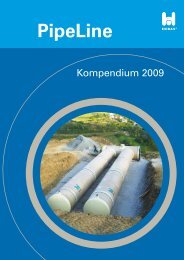PipeLine - Hobas Pipes
PipeLine - Hobas Pipes
PipeLine - Hobas Pipes
Create successful ePaper yourself
Turn your PDF publications into a flip-book with our unique Google optimized e-Paper software.
h <strong>PipeLine</strong> | Compendium 2009 | Page 27<br />
With or without Trench - always with h!<br />
Renovation of a Sewer Main in Strasbourg, France<br />
The reconstruction of the sewer main for the Rhine Harbour of Strasbourg<br />
was a model example of the complementary nature of open-dig<br />
and trenchless installation. Where the working space would have been<br />
insufficient, rehabilitation was carried out by sliplining prefabricated<br />
GRP NC Line ® panels. Wherever a trench was feasible, CC-GRP<br />
<strong>Pipes</strong> were laid in an excavated trench which was prepared in<br />
accordance with pipe installation standards and as the depth<br />
required.<br />
The project, coordinated by the Water and Sanitation<br />
Division of the Urban Community of Strasbourg, involved<br />
the renovation of an egg shaped main dimensioned<br />
1,400 x 1,900 mm that functions as combined<br />
sewer for domestic and industrial effluents. 980 m<br />
DN 1500 CC-GRP pipe were lowered into a trench<br />
with a depth varying between 3 and 9 m. Over a<br />
stretch of 550 m the existing egg shaped structure<br />
was sliplined utilizing GRP NC Line ® panels with an<br />
internal dimension of 1230 x 1660 mm.<br />
The concept and implementation of mixed installation<br />
techniques for the project was particularly innovative<br />
and pragmatic. All pipe material was supplied by<br />
HOBAS. “We were looking for the best techno-economical<br />
compromise and this led us to selecting these<br />
techniques for this project. The performance of the<br />
2 methods and the pipe material had to be taken into<br />
account while keeping environmental impacts to a minimum.<br />
Trenchless installation enabled the industrial roadway<br />
to remain open for use and us to comply with budget and safety<br />
considerations”, explains Marc Hunsinger, head of the CUS Water<br />
and Sanitation Networks department. This project was coordinated by<br />
a consortium where SMCE Réha was responsible for the trenchless<br />
section and EJL Alsace for the open-dig section.<br />
The sewer main that was relined has a curved section and therefore<br />
required the use of panels in different lengths varying from 1 to 2.35 m.<br />
These were inserted in the main with the help of a trolley and fitted<br />
together with a hydraulic jack. Then the panels were held in place<br />
with wooden wedges and finally fixed by grouting the annulus.<br />
For the structural rehabilitation, the 25 mm thick NC Line walls have<br />
been calculated to ensure the optimal performance of the new line.<br />
This system not only transfers vertical loads (ground and heavy industrial<br />
traffic) but above all withstands aggressive substances from effluents<br />
from agronomical industrial plants with pH levels ranging from 1 to 10.<br />
The sewer’s leak tightness is guaranteed by EPDM rubber seal integrated<br />
in each PN 1 connection.



